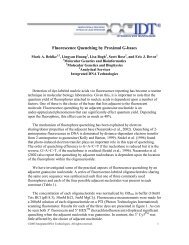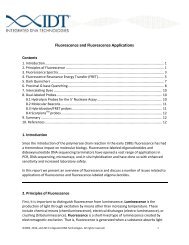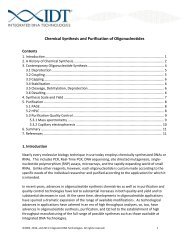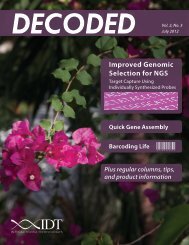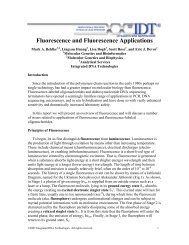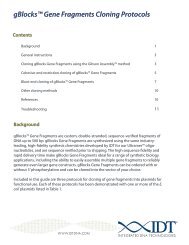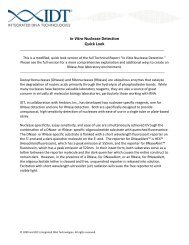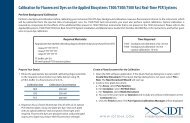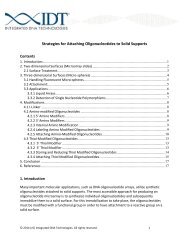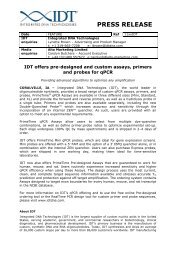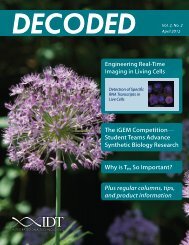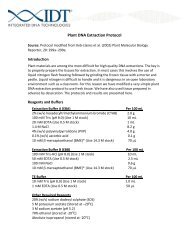Improved Print and QC Methods for Oligonucleotide Arrays
Improved Print and QC Methods for Oligonucleotide Arrays
Improved Print and QC Methods for Oligonucleotide Arrays
You also want an ePaper? Increase the reach of your titles
YUMPU automatically turns print PDFs into web optimized ePapers that Google loves.
We suspect that the hydrazide-modified probes are covalently coupling with the amine-slide surface<strong>and</strong> further that this reaction does not directly involve the primary amine group but rather is an interactionwith other elements of the surface coating. Attachment of hydrazide-oligos varies significantly betweenamine slides from different sources. A total of four different sources were tested (data not shown) <strong>and</strong> theCorning GAPSII <strong>and</strong> UltraGAPS surfaces were the most reactive. Increased probe-density <strong>and</strong> greaterultimate sensitivity can be achieved using IDT’s print buffer <strong>and</strong> hydrazide-modified probes with CorningGAPSII slides. This combination consistently yields more intense hybridization spot signals with greateruni<strong>for</strong>mity than any other combination tested.A) 3X SSC1.5M Betaine IDT 50% DMSOUltraGAPS no heat couplingB) 3X SSC1.5M Betaine IDT 50% DMSOGAPSII no heat couplingC) 3X SSC1.5M Betaine IDT 50% DMSOSuperAmine no heat coupling1-u1-a1-h1-A1-H7-u7-a7-h1-u1-a1-h1-A1-H7-u7-a7-h1-u1-a1-h1-A1-H7-u7-a7-h1-u1-a1-h1-A1-H7-u7-a7-h1-u1-a1-h1-A1-H7-u7-a7-h1-u1-a1-h1-A1-H7-u7-a7-h1-u1-a1-h1-A1-H7-u7-a7-h1-u1-a1-h1-A1-H7-u7-a7-h1-u1-a1-h1-A1-H7-u7-a7-hUltraGAPS w/heat couplingGAPSII w/heat couplingSuperAmine w/heat couplingEffect of Attachment Chemistry, <strong>Print</strong> Buffer, <strong>and</strong> HeatCoupling on Corning UltraGAPS SurfaceEffect of Attachment Chemistry, <strong>Print</strong> Buffer, <strong>and</strong> HeatCoupling on Corning GAPSII SurfaceEffect of Attachment Chemistry, <strong>Print</strong> Buffer, <strong>and</strong> HeatCoupling on TeleChem SuperAmine Surfaceno heatheatno heatheatno heatheat100%100%100%80%80%80%60%60%60%40%40%40%20%20%20%0%1u-sb1a-sb1h-sb1A-sb1H-sb7u-sb7a-sb7h-sb1u-IDT1a-IDT1h-IDT1A-IDT1H-IDT7u-IDT7a-IDT7h-IDT1u-D1a-D1h-D1A-D1H-D7u-D7a-D7h-DAttachment Chemistry & <strong>Print</strong> Buffer0%1u-sb1a-sb1h-sb1A-sb1H-sb7u-sb7a-sb7h-sb1u-IDT1a-IDT1h-IDT1A-IDT1H-IDT7u-IDT7a-IDT7h-IDT1u-D1a-DAttachment Chemistry & <strong>Print</strong> Buffer1h-D1A-D1H-D7u-D7a-D7h-D0%1u-sb1a-sb1h-sb1A-sb1H-sb7u-sb7a-sb7h-sb1u-IDT1a-IDT1h-IDT1A-IDT1H-IDT7u-IDT7a-IDT7h-IDT1u-D1a-DAttachment Chemistry & <strong>Print</strong> Buffer1h-D1A-D1H-D7u-D7a-D7h-DFigure 2: Specific Target Hybridizations Comparing <strong>Print</strong> Buffers <strong>and</strong> AttachmentChemistries on Different Amine Surfaces. 70mer oligo probes (1 is 25.7% GC <strong>and</strong> 7 is 55.7% GC) wereprinted @25µM using 3 different print buffers on UltraGAPS (A), GAPSII (B), <strong>and</strong> SuperAmine (C) slideswith a 3 hour humidity treatment, followed either with (bottom array) or without (top array) heat-coupling.<strong>Arrays</strong> were hybridized with Cy3-40mer specific-targets @200nM each in 1X HybIt® (TeleChem). Imagesare 5µm resolution scans using ScanArray® 5000 (Perkin Elmer) at 63/63 laser (power/gain) settings. (Pseudocolorscale: black



